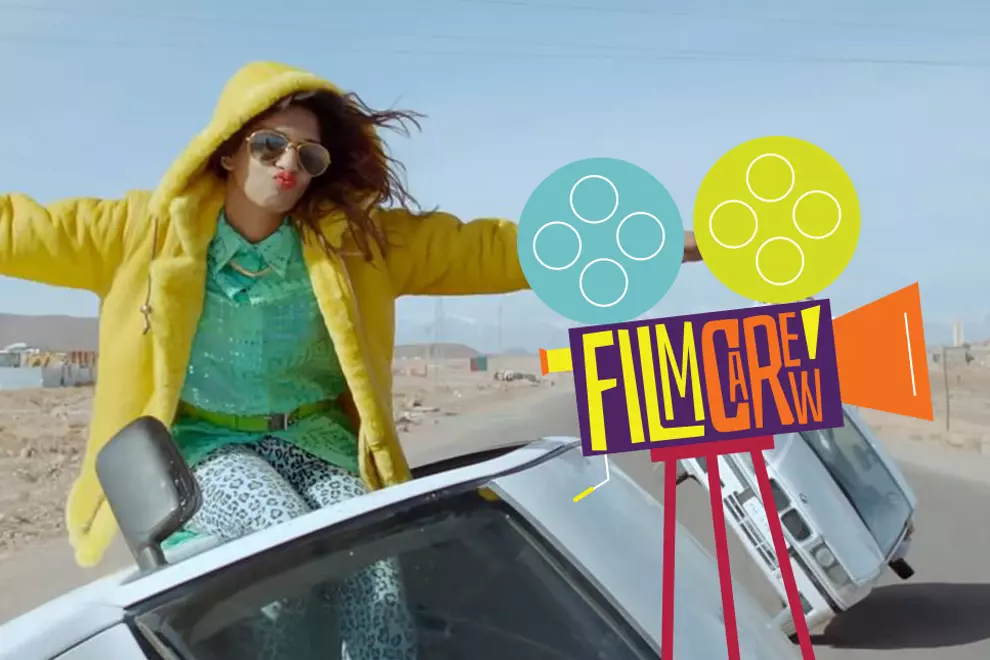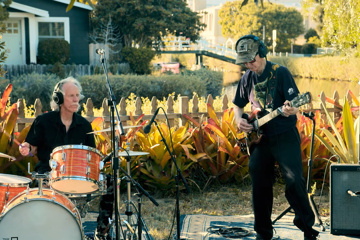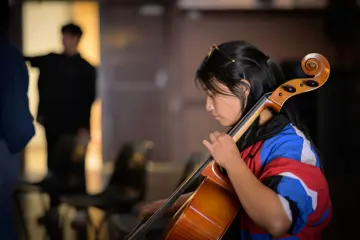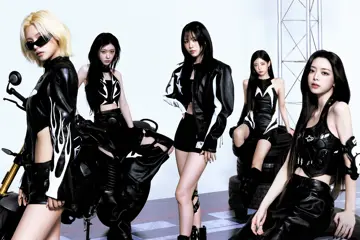 M.I.A.
M.I.A.MATANGI/MAYA/MIA
★★★1/2
As with every music documentary, it’s important, with Matangi/Maya/MIA, to note this from the start: there’s no celebrity talking-heads. No Bono. No Thurston Moore. No Henry Rollins. This isn’t your standard pro-forma rockumentary, celebrating the music and career of Maya Arulpragasam, the 43-year-old alt-pop star who’s found fame, notoriety, and controversy under the name MIA.
Steve Loveridge’s documentary, instead, makes Arulpragasam the protagonist of her own story. The director — who went to art school with his subject, thus has proximity to the person, not the myth — has been blessed with a cache of ‘archival footage’, videos personally shot by Arulpragasam, who initially hoped to be a documentary filmmaker, at key moments of her life and career.
There’s amazing footage of a pre-MIA 2000 tour with Elastica, where Arulpragasam has gone on the road with the Brit-pop outfit as videographer, budding documentarian, and friend of bandleader Justine Frischmann; where the spectre of the music industry, and its condescending treatment of women, arises. There’s stark to-camera confessionals from a lonely Arulpragasam, too, giving the doc an instant sense of intimacy, and positioning her as an isolated, individualist figure.
The most striking old, personal video, though, comes from a 2001 trip to Sri Lanka. Arulpragasam — whose family is Tamil — had emigrated to the UK as an eleven-year-old, in 1986; this was her first trip back to her homeland. There, she visits her old house, and old stomping grounds, reunited with relatives and friends. MIA had long been criticised for promoting a spraypainted image of terrorist-chic, but this footage shows how the Tamil struggle was indivisible from her life, and how it influenced her art. When a cousin says to Arulpragasam, “You never had the warzone experience,” it’s not said with envy or as benediction, but as a dismissal; there status to be found in surviving in the toughest climes, in living the struggle on the ground.
Don't miss a beat with our FREE daily newsletter
In Matangi/Maya/MIA, we return to this 2001 footage thrice over: before her career has begun, when her success is at its peak, and at the film’s end. In Loveridge’s estimation, it’s a definitive event in her life, and a way of situating Arulpragasam’s career as part of a bigger picture, both in terms of the subject’s life, and in terms of greater global/political conflict.
Throughout, we get served the hits — Galang, Paper Planes, Bad Girls — but also the dust-ups and blow-ups familiar to any fans: when she was dubbed a terrorist in the US media (an interview with Bill Maher, herein, is a shocking study in paternal condescension and old-white-male dickitude); the ‘truffle fries’ hit-piece by the conservative-as-fuck New York Times; and the time when, performing with Madonna at the Super Bowl, she somehow offended the bastions of a sport synonymous with militarism/modern-slavery/brain-damage by daring to raise the middle finger.
This Super Bowl moment, in all its ridiculous absurdity, is captured in amazing backstage vérité, where, in distorted home-video, the grandeur of the platform is made surreal. Here, you see the weight of what’s happened set in, as Arulpragasam and crew realise that such a flippant, minor gesture of recalcitrance could bring with it a shit-storm. Loveridge soon cuts to the hysterical overreaction by right-wing news pundits, but, the fact that a professional sports-league tried to sue a performer $16.6mil for raising a finger is so utterly incomprehensible that the fact can only really become a fleeting, bizarre laugh, here; you could really make an entire documentary about this one incident.
Matangi/Maya/MIA doesn’t dodge these grand moments of controversy, but it doesn’t feel the need to centre the film around them. It’s not a film about the media perception of Arulpragasam, more about her self-perception. It spends time with its subject, either in contemporaneous footage or by having her talk in hindsight; making it a study of an artist on their own terms.
SKATE KITCHEN
★★★
Crystal Moselle met the subjects of her first film, the incredible 2015 documentary The Wolfpack, on the streets of New York City; meeting this family of boys who’d grown up in some Dogtoothian lockdown, and finding a story worth the years that she’d sink into telling it. Her second film, this time a narrative feature called Skate Kitchen, came into being in the same way. In a subway carriage, she met the girls of the titular, social-media-savvy skate collective, and a rapport turned into friendship and collaboration. These films are wholly different — documentary vs narrative; stranger-than-fiction vs genre-familiar; group of males vs group of females — but were born in a similar way, and carry a similar spirit.
Skate Kitchen — one of a trio of notable 2018 skater movies, alongside m and Mid90s — gives us a teenage rebel without a cause, Camille (Rachelle Vinberg), who’s constantly fighting with her mum about her love of skateboarding but hatred of school. Here is in easy ‘in’ for any audience member: this is the familiar pissed-off teen lead, seeking liberation, their own identity. Skateboarding turns from refuge to vehicle of discovery, when Camille — like Moselle before her — crosses paths with the girls of Skate Kitchen. What follows is pretty standard-issue coming-of-age stuff: adolescent recalcitrance, rebellion against controlling parents, new pals, first loves, local rivals, bad choices, self-destruction, and an essentially existential search for what to do with your life, and who to be.
Whilst these sound, in many ways, like tropes, Moselle rarely pushes them forward with too much force, never erects a three-act structure around them. She doesn’t, in truth, fashion a sharp, incisive narrative. Instead, she observes with a documentarian’s eye; only the moments of group antagonism and violence feeling like inserted drama. What she’s out to capture isn’t, in a grander sense, these coming-of-age mores, but how it feels to be a young woman in a male-dominated counter-culture, to exist in a scene, to be a part of a community, to find a gang of friends.
PIERCING
★★★★1/2
In a hyper-stylised, surreal, ersatz nocturnal realm — which effectively lands somewhere between peak De Palma and the nasty gialli he riffed on — a handsome young husband and buttoned-up salaryman (Christopher Abbott) has a plan. The murderous impulses he feels are a problem, something that won’t do when he has, at home, a loving wife (Laia Costa) and infant child. So, he kisses them goodbye, and heads off on a ‘business trip’, where the business at hand is calling up a call girl, inviting her into his hotel room, and doing away with her. He’s well-researched and well-rehearsed, meaning it should all go off without a hitch. But, when his called girl, Mia Wasikowska, walks into this unreal world, best-laid plans go to waste.
A film about a murderous man out to kill a sex worker seems like a tin-eared premise for this contemporary moment, but, in Piercing, nothing is what it seems. Director Nicolas Pesce — following up his Gothic-American micro-budget debut The Eyes Of My Mother — is adapting a story by cult Japanese novelist Ryû Murakami, who cinephiles and/or fans of fucked-up, midnight-movie experiences last saw being brought to screen with Takeshi Miike’s 1999 classic Audition. That film is one of cinema’s grandest, giddiest, creepiest subversions of patriarchal predation; the ultimate gender-flipped counterpoint to the macho 'business-as-usual' of torture-porn. Here, there’s torture, and a man who turns from predator to prey, but the story is a little more slippery.
What the film becomes is a study of a weird micro-relationship; the hotel room becoming a world unto itself, a republic of two. Whilst Abbott’s character comes from a functional relationship (Costa is a wife so supportive, she’s all for his murderous plot, offering on-the-phone counsel when hubby wavers), Piercing is a gleeful, giddy portrait of a dysfunctional one. With Wasikowska playing a genuine agent of chaos, the narrative never signals any specific direction; radically reversing only to double back, or get tied in knots. It’s a study of relationship power-dynamics, one in which the question of what’s happening —Is this meta-performance? Earnest exploitation? Fatal attraction? Mutual self-destruction? Elaborate role-play? Grand fetishry?— is never answered. It makes for a wild, wicked, hilarious, genuinely thrilling descent into the darkness; a movie so good it was Film Carew’s #8 film of the past year.
LORO
★★★
Loro is the latest Paolo Sorrentino film, and the most Paolo Sorrentino film. It’s a fantastical portrait of infamous Italian head-of-state Silvio Berlusconi, media-mogul turned prime-minister turned human embodiment of grotesque greed and sleazy patriarchy. After the run of Il Divo, The Great Beauty, Youth, you know what to expect from Sorrentino: grotesque old men and semi-naked young women, glitzy party sequences showing ribald bacchanal in slow-motion, Italian high-society depicted in all its grotesquerie, elaborate tracking-shots picking through impressive architecture, ironic counterpoint between pop-song sentiments and on-screen horrors. His tone lands somewhere between Bubblegum Scorsese and Eurotrash Luhrmann; all eye-popping, coked-out excess, show-offy directorial grandeur, and bountiful male ego (both in front of and behind camera).
At 150-minutes long (having been cut down from a 200-minute, two-part picture released in Italy separately), Loro serves up more of everything: more set-pieces, more slow-motion, more ironic use of sad music, more young females, more repulsive old men. In many ways, it’s a grand shrine to Berlusconi as cinema, a monument to bad taste and over-the-top ambition built with those qualities. Toni Servillo, Sorrentino’s long-time leading man (shouts to The Consequences Of Love), efforts to bring humanity to the sad clown at the centre of this grand cinematic circus, but too often he’s a tiny figure amidst a swirl of grand production design.
Amidst all its loopy excesses, there’s moments worth savouring; especially when the film gets tart, acidic, satirical. Sorrentino, as always, never loses a sense of the absurd, and knows how to create stark juxtapositions between repulsive wealth, squalid suffering, and the social-climbers who try to bridge the gap between the two. But, taken as bloated whole, Loro is too much, too long, too familiar. Where Il Divo felt like a takedown of Italian political conservatives that was driven by righteous rage, Loro feels far more self-satisfied; plays more like Sorrentino going through the motions than rising to new heights.
MARY, QUEEN OF SCOTS
★★1/2
It’s probably the first frocked-up Oscarbait period-piece in which a monarch receives mind-altering cunnilingus and has her menstrual blood wiped up by partners-in-crime/female-bonding handmaidens. But, beyond some mild redressing of gender imbalance in films about royalty and skulduggery in the candlelit yore, Mary, Queen Of Scots largely plays as mediocrity. There’s headstrong-women-who’re-ahead-of-their-time, wearing fancy frocks. There’s wigs. There’s all manner of elaborate hooped hair-dos. There’s bad accents. There’s Guy Pearce’s panto-esque performance, which is probably the worst of his career. There’s exterior shots that feel like B-roll cribbed from the Scottish Tourist Board. There’s a score which can be summarised as ‘Generic Swelling Strings’. Even the palace intrigue ain’t so intriguing.
Buried beneath the banality is a critique of institutionalised patriarchy, its depiction of the sufferings of its titular heroine — doubted at every turn, with moralising misogynists dragging her down from her position of power — carrying grand symbolism. But the film is too mannered to play as cry-of-rage, its screenplay (by Beau Willimon) too banal to function as greater social satire or broadside. It’s another non-threatening entry into the overpopulated realm of ‘historical portraits of royalty’, made to look even more mediocre and meaningless due to arriving in the wake of Yorgos Lanthimos’s acidic, awesome The Favourite.
Its best sequence comes with a top-secret backroom rendezvous between twin Queens — Saoirse Ronan playing the titular Scottish monarch, a dressed-down Margot Robbie as England’s Queen Elizabeth — which takes place in a laundry house. The women are divided by hanging cloths and clothes, each unseen to the other; the fabrics often foregrounded in frame. It’s a nice enough scene, but it feels like the BBC-telemovie version of the genuinely magical visuals of Hou Hsiao-hsien’s The Assassin. It’s one of the few moments in which filmmaker Josie Rourke — a much-acclaimed theatre veteran making her directorial debut — actually makes Mary, Queen Of Scots feel cinematic. The rest of the time it plods along, self-satisfied and stagey. It’s a work of neither sobering history-lesson nor righteous revisionist history; neither salty nor sweet. It’s bland and easily-digestible, and imminently forgettable.
















